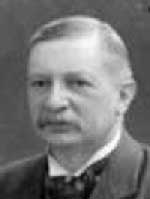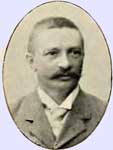.
Johannes Robert Rydberg

Johannes Robert Rydberg, (‘Janne’ to his friends), (November 8, 1854 – December 28, 1919), was a Swedish physicist mainly known for devising the Rydberg formula, in 1888, which is used to predict the wavelengths of photons (of light and other electromagnetic radiation) emitted by changes in the energy level of an electron in an atom.
The physical constant known as the Rydberg constant is named after him, as is the Rydberg unit. Excited atoms with very high values of the principal quantum number, represented by n in the Rydberg formula, are called Rydberg atoms, and a crater on the moon is also named Rydberg in his honour. Rydberg's faith that spectral studies could assist in a theoretical understanding of the atom and its chemical properties was justified in 1913 by the work of Niels Bohr (see hydrogen spectrum). An important spectroscopic constant based on a hypothetical atom of infinite mass is called the Rydberg (R) in his honor.

He was active at Lund University, Sweden, for all of his working life.
See also
* Rydberg formula
* Rydberg constant
References
* Mike Sutton, “Getting the numbers right – the lonely struggle of Rydberg” Chemistry World, Vol. 1, No. 7, July 2004.
* Martinson, Indrek; L.J. Curtis (2005). "Janne Rydberg – his life and work". NIM B 235: 17-22.
Links
* O'Connor, John J. & Robertson, Edmund F., "Johannes Rydberg", MacTutor History of Mathematics archive
Retrieved from "http://en.wikipedia.org/"
All text is available under the terms of the GNU Free Documentation License

